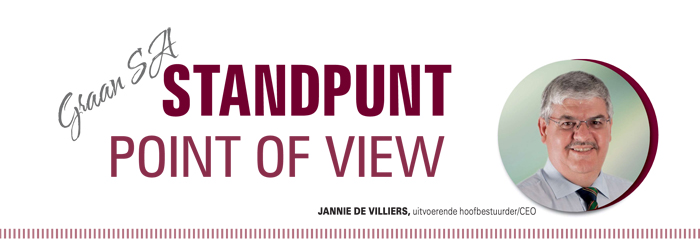August 2017

Jannie de Villiers, CEO
I really grew up poor. There was always enough to live from but almost never too much. Nevertheless, somewhere in my life my mother taught me the lesson of ‘too much of a good thing is not good’ – like eating too much sweets and drinking too many cool drinks at a party of the rich kids in town. You then develop a stomach ache and can even become nauseous with negative results.
Year after year we dream of bumper crops and in our prayers, we wish it for each other when the planting season begins or with birthdays. Now we are there with regards to the current summer grain crop. This really is abundance! Can too much of a good thing ever be bad?
The abundance of maize definitely has extraordinary challenges. The chaser bins groan, the trucks are getting full, the grain elevators are overflowing, but the bank accounts remain empty. How must one evaluate such a situation?
It is still too early to review the season, but let us start by being grateful. The same grain fields that are now yielding record crops for most of us, were almost blown away a few months ago. Filling the chaser bins last year was a long process. Our grain elevators had to make space for foreign maize from far away countries.
Grain SA was still in the midst of discussions about drought relief and new research plans to import drought and heat resistant maize cultivars from overseas when the producers pressed the ‘reset’ button requiring us to start searching for export markets. These events and extraordinary fluctuations resulted therein that the marketing of maize became even more important. It is definitely one of the most expensive lessons we have learnt from this year of abundance. The prices hurt deeply, very deeply!
The continuous calls to our office about training in how to do better hedging are clear proof of it. Hopefully the reaction to the past two years of extremes – new research to counter drought and improved knowledge to manage price risks – is the combination required to remain sustainable.
‘To know or not to know’ is the story of the wheat tariff. Following a very successful court application to force the Minister to announce the old tariff, the Minister requested that the whole tariff system be investigated again. They were of the opinion that the tariff was too high.
High food prices, a weak exchange rate (and we know who caused that) and an election were the main drivers for their decision. Grain SA spent hours and hours preparing documentation and negotiating. Our main purpose was to keep the old model and keep the tariff as high as possible – especially in the knowledge that the government had only one goal in sight – it had to be lower.
The tension in the wheat industry was at a breaking point and the leaders were later of the opinion that a lower tariff announced now would be better than a tariff not being published. Just let the uncertainty stop, they asked. Nothing was traded.
The final outcome thereof was a lower tariff, but not so much as we expected at one stage. That some producers were not expecting it, leaves question marks with regards to our communication skills, or the reading ability of producers. The market came to a standstill for months waiting for the announcement that could only have one outcome. Yet it was a surprise for some of us.
Part of sustainability is definitely to read and keep your ears open – especially if it is about the prices of your products. Despite better agricultural conditions most grain producers are suffering financially.
Our plans are not yet at an end. Keep the faith, producers!
Publication: August 2017
Section: Features

















